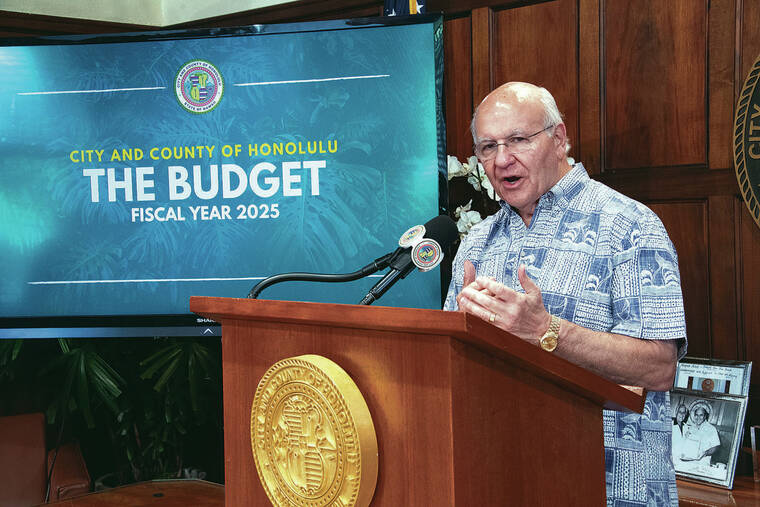City’s nearly 2,500 vacancies lead budget talks

CRAIG T. KOJIMA / MARCH 1
Mayor Rick Blangiardi — here holding a news conference after delivering fiscal year 2025 operating and capital improvement project budget bills to the City Clerk’s Office — made a brief appearance Monday during the City Council’s special budget hearing.

CRAIG T. KOJIMA / MARCH 1
Staffers move budget documents at City Hall.


A formal review of Honolulu Mayor Rick Blangiardi’s proposed $3.63 billion operating budget for the 2025 fiscal year, which begins July 1, prompted discussion over the city’s nearly 2,500 worker vacancies.
During the City Council’s first special budget hearing Monday, Chair Tommy Waters requested more information directly from Blangiardi — who made a brief appearance inside Council chambers, prior to the panel’s lengthy scrutiny of the mayor’s funding priorities, including affordable housing and homeless services — to fill the unfilled positions of the city’s almost 10,000-person workforce.
But first, Waters offered his remedy to the city’s number of unfilled positions, which he said amounts to nearly $170 million in budgeted yet unused city funds.
“I know it’s been a priority of the administration to start hiring,” said Waters, “but I believe that eliminating or updating obsolete positions is a critical component of our ability to budget responsibly and transparently, particularly if we are to ensure the continued operation of critical services and raise the salaries for some of our particularly hard-to-fill positions here at the city.”
And based on city data, he added, “Vacant positions rarely, if ever, are designated for abolishment.”
“I guess, in a nutshell, what I’m thinking is if we’re to take positions that haven’t been filled for five or 10 years and are not likely to be filled, let’s just get rid of them,” Waters said.
Don't miss out on what's happening!
Stay in touch with breaking news, as it happens, conveniently in your email inbox. It's FREE!
In response, the mayor said he was “not against that” idea.
However, Blangiardi cautioned that despite his administration’s focus on filling vacancies, it hasn’t been easy to do — particularly within the city’s largest agencies such as Honolulu Police Department, which has over 400 unfilled positions.
“As I was advised, some of those positions that have been on the books for a long time, they’re always hesitant to take them off,” he said. “What we’re trying to do right now is create a ‘reality workforce.’”
Currently, he said, the city has about 8,300 full-time equivalent positions and over 1,500 positions working under “personal service contracts” — essentially outside, private contractors — acknowledging the city would like “to convert those” to fill in the departments that “really need the labor.”
“I am pleased with the progress that we’re making,” he added. “I’ve said right from the beginning when we tried to take this on as a major issue, it would take us the duration of two terms to kind of get it going.”
Blangiardi, in the midst of wrapping up his first four-year mayoral term, has officially launched his reelection campaign for the city’s top elective post in November.
Meantime, Waters said he believes city departments should “utilize salary funds” from unfilled positions.
“What if we just take away the (unfilled positions) and just give them the cash, equal to what they’re requesting, but we just get rid of those positions?” he said. “We’re not likely to fill them if they’ve been vacant for 10 years.”
To that, Blangiardi said part of this new budget proposal includes a request for about $4 million dedicated toward city “pay raises” — presumably to attract more job seekers to local government.
Radiant Cordero, the Council’s Budget Committee chair, also wondered why some obsolete positions — like typists — were still active job descriptions at the city.
“Essentially, their job was to do things via typewriter which we don’t do anymore, so when are you going to start abolishing those … obsolete positions?” she asked.
Blangiardi replied, “To be candid with you, I’ve not done a deep dive on those positions you’re talking about, (but) I’m open to doing that and what makes sense.”
Later, Waters questioned city staff on ways to redirect budgeted funds toward the city’s stated priorities. Specifically, he noted the city currently has “330 vacant positions that have been vacant for over five years.”
“That totals $20,321,700,” said Waters. “And 212 positions that have been vacant for over seven years, totaling $12,709,068. So can we take these vacant positions and put that toward affordable housing and/or dealing with our homelessness problem.”
Andy Kawano, director of the city Department of Budget and Fiscal Services, said, “I wish it was that simple.”
He added, “When you look at numbers at the very top level — we’re talking about the government as a whole — the vacancies have different funding sources.”
“So the total vacancy amount at any given time could be $70 (million) to $80 million,” he said, noting a smaller fraction — about $30 million to $40 million — originates from the city’s general fund, which pays for things like city employee salaries, via property tax revenues. “The rest are all funded by special funds, federal funds and other funds with restrictions, so you won’t be able to use the moneys for whatever you want.”
He added, “If we remove vacancies, you’ve got to go down to the position and look at a granular level as to what the position is there for — the objective, the funding source — because if it’s not general fund, (it can’t be used).”
The budget director noted that within his own department, “in our five- to seven-year … vacancies, we have nine or 10 positions.”
“All of them are federally funded,” Kawano said. “We haven’t abolished any positions because frankly, we’re still figuring things out, figuring out what we really need,” adding he would “not abolish any of those positions.”
Still, Waters said the city’s 2,425 vacant positions equaled $169,000,420.
“Again, not all of that money is general fund moneys,” Kawano replied.
“Right,” said Waters, “but how much of this can we find to fund the mayor’s priorities of housing and homelessness? Out of that $169 million, you’re saying nothing, we can’t take any of that?”
Kawano said added funding had come from “trimming” city departments, resulting in “a few million dollars of general fund moneys.”
“And as the mayor stated, one of his priorities is to hire, to right-size staffing,” Kawano said, adding, “What we saw coming in as a new administration is that we would post positions with the verbiage ‘subject to funding.’”
And “if you were looking for a job, especially now, where unemployment is relatively low, would you spend a lot of time applying to a job that’s ‘subject to funding’?” Kawano asked. “I wouldn’t.”
Meanwhile, under the mayor’s proposed $3.63 billion budget — a 6.4% increase over the city’s current $3.41 billion budget — the largest category of expenditures for the upcoming fiscal year is $844.7 million, meant to fund city employee benefits, including nondiscretionary costs like health care, retirement and other post-employment benefits, the city says.
On operational costs, including salaries, the city’s public safety and public health agencies — police, fire and Emergency Services Department — represent roughly 17% of the pro- posed operating budget, or $626.7 million, the city says.




